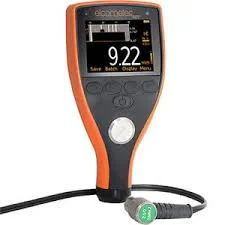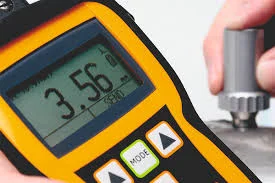Ultrasonic testing (UT) is a non-destructive testing (NDT) method that utilizes high-frequency sound waves to detect imperfections and measure material thickness. This technique is widely used in various industries, including manufacturing, aerospace, automotive, and construction, due to its effectiveness in ensuring the integrity of materials and structures. In this blog, we will explore the advantages and features of ultrasonic testers, shedding light on why they are an essential tool in quality control and maintenance.
Understanding Ultrasonic Testing
Before delving into the advantages and features of ultrasonic testers, it is important to understand how ultrasonic testing works. The process involves sending ultrasonic waves into a material and analyzing the reflected waves to identify any discontinuities or flaws. The basic components of an ultrasonic testing system include:
Transducer: Converts electrical energy into ultrasonic waves and vice versa.
Pulser/Receiver: Generates the electrical pulse that excites the transducer and receives the reflected signals.
Display Unit: Visualizes the data collected, often in the form of waveforms or graphs.
Software: Analyzes the data and provides detailed reports.
Ultrasonic testing can be performed in various modes, including pulse-echo, through-transmission, and resonance testing, each suited for specific applications.

Advantages of Ultrasonic Testers
1. Non-Destructive Testing
One of the most significant advantages of ultrasonic testing is that it is a non-destructive method. This means that the integrity of the material being tested remains intact, allowing for the continued use of the component or structure. This is particularly important in industries where safety and reliability are paramount, such as aerospace and nuclear power.
2. High Sensitivity to Flaws
Ultrasonic testers are highly sensitive to small flaws, such as cracks, voids, and inclusions. This sensitivity allows for the detection of defects that may not be visible through other testing methods, such as visual inspection or radiography. The ability to identify these flaws early can prevent catastrophic failures and costly repairs.
3. Versatility
Ultrasonic testing can be applied to a wide range of materials, including metals, plastics, ceramics, and composites. This versatility makes ultrasonic testers suitable for various applications, from inspecting welds and castings to measuring the thickness of coatings and pipes. Additionally, ultrasonic testing can be performed on both flat and curved surfaces, making it adaptable to different geometries.
4. Depth Penetration
Ultrasonic waves can penetrate deep into materials, allowing for the inspection of thick components. This depth penetration is particularly beneficial in industries such as oil and gas, where pipelines and storage tanks may be several inches thick. The ability to assess the internal structure of materials without cutting or damaging them is a key advantage of ultrasonic testing.
5. Real-Time Results
Ultrasonic testers provide real-time results, enabling immediate analysis and decision-making. This feature is crucial in production environments where time is of the essence. Operators can quickly assess the quality of materials and make necessary adjustments to processes, reducing downtime and improving overall efficiency.
6. Cost-Effectiveness
While the initial investment in ultrasonic testing equipment may be higher than other NDT methods, the long-term cost savings are significant. By identifying defects early, companies can avoid costly repairs, downtime, and potential safety hazards. Additionally, ultrasonic testing can reduce the need for extensive destructive testing, further lowering costs.
Key Features of Ultrasonic Testers
1. Advanced Signal Processing
Modern ultrasonic testers are equipped with advanced signal processing capabilities that enhance the accuracy and reliability of test results. Features such as digital filtering, automatic gain control, and waveform analysis allow for better interpretation of the data collected. This technology helps operators distinguish between genuine defects and noise, leading to more accurate assessments.
2. Multiple Testing Modes
Ultrasonic testers often come with multiple testing modes, such as A-scan, B-scan, and C-scan. Each mode provides different visual representations of the data, allowing operators to choose the most suitable method for their specific application. This flexibility enhances the effectiveness of ultrasonic testing in various scenarios.
3. Data Storage and Reporting
Many ultrasonic testers are equipped with data storage capabilities, allowing operators to save test results for future reference. This feature is particularly useful for quality control and compliance purposes, as it enables organizations to maintain detailed records of inspections. Additionally, advanced reporting software can generate comprehensive reports that include graphs, images, and analysis, facilitating communication with stakeholders.
4. Portability
Portability is a crucial feature for ultrasonic testers, especially in field applications. Many modern ultrasonic testers are lightweight and battery-operated, making them easy to transport and use in remote locations. This portability allows for on-site inspections, reducing the need for transporting materials to a testing facility.
5. User-Friendly Interfaces
The user interface of ultrasonic testers has evolved significantly, with many models featuring touchscreens and intuitive navigation. This user-friendly design simplifies the testing process, allowing operators to focus on the inspection rather than struggling with complex controls. Some devices even offer customizable settings, enabling users to tailor the equipment to their specific needs.
6. Compatibility with Other NDT Methods
Ultrasonic testers can often be integrated with other non-destructive testing methods, such as magnetic particle testing or dye penetrant testing. This compatibility allows for a comprehensive assessment of materials, providing a more complete picture of their integrity. By combining different NDT techniques, organizations can enhance their quality control processes and ensure the reliability of their products.

Conclusion
Ultrasonic testers are invaluable tools in the realm of non-destructive testing, offering numerous advantages and features that enhance their effectiveness and versatility. From their ability to detect small flaws in various materials to their real-time results and cost-effectiveness, ultrasonic testing plays a critical role in ensuring the safety and reliability of components and structures across multiple industries.
Understanding Ultrasonic Testers: Principles and Applications
